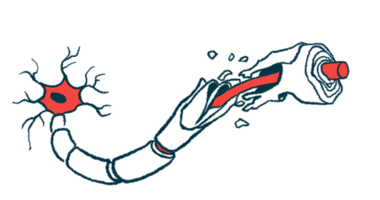Mitochondrial problems linked to loss of motor control cells in MS
Targeting cells' powerhouses may prevent worsening impairment: Study

Mitochondrial abnormalities, or problems in the powerhouses of cells, seem to be a main contributor to the death of important nerve cells in the cerebellum — a brain region involved in motor control — in people with multiple sclerosis (MS), a new study suggests.
Researchers found that inflammation and the loss of myelin — the protective sheath around nerve fibers — in the cerebellum disrupts the function of mitochondria, leading to an energy deficit that ultimately kills the nerve cells.
The findings suggest that targeting mitochondria function could be a way to protect these neurons, called Purkinje cells, and prevent motor impairments from worsening, according to the researchers, from the University of California Riverside School of Medicine.
“Our study … proposes that inflammation and demyelination in the cerebellum disrupt mitochondrial function, contributing to nerve damage and Purkinje cell loss,” Seema Tiwari-Woodruff, PhD, professor of biomedical sciences and leader of the research team, said in a university news story, which noted that about 80% of MS patients have inflammation in this brain region.
“This research brings us a step closer to understanding the complex mechanisms of MS and developing more effective, targeted treatments for this debilitating disease,” Tiwari-Woodruff said.
The study, “Decreased mitochondrial activity in the demyelinating cerebellum of progressive multiple sclerosis and chronic EAE contributes to Purkinje cell loss,” was published in Proceedings of the National Academy of Sciences (PNAS).
MS is caused by an erroneous immune attack against myelin, resulting in inflammation and damage that leads to a wide range of MS symptoms. Chronic inflammation is also thought to contribute to mitochondrial dysfunction, interfering with how nerve cells produce and use energy.
In most people with MS, the cerebellum — a brain region located at the back of the head that helps coordinate muscle movements — is affected, contributing to motor impairments among patients. However, the exact mechanisms behind cerebellar dysfunction in MS have not been clear.
Using human brain tissue to investigate mitochondrial problems in MS
To learn more, the team set out to assess whether mitochondrial problems could contribute to the progressive loss of Purkinje neurons, which are important nerve cells in the cerebellum.
“These large, highly active cells help coordinate smooth, precise movements — like dancing, throwing a ball, or even just walking. They’re essential for balance and fine motor skills,” Tiwari-Woodruff said.
The researchers first analyzed postmortem cerebellar tissue from people who’d had progressive forms of MS. Those results showed a significant loss of myelin, as well as inflammation, nerve fiber degeneration, and loss of Purkinje cells, compared with cerebellar tissue from healthy controls.
The tissue from patients also exhibited a lower activity of the mitochondrial complex IV (COXIV), a protein essential for the production of energy by mitochondria, inside Purkinje cells.
“Our research looked at brain tissue from MS patients and found major issues in these neurons: they had fewer branches, were losing myelin, and had mitochondrial problems — meaning their energy supply was failing,” Tiwari-Woodruff said.
Findings in mice suggest new therapeutic target for MS
These effects were mirrored in mice with experimental autoimmune encephalomyelitis (EAE), an induced disease that’s commonly used to mimic MS in mice. In particular, the EAE mice also showed increased inflammation and demyelination, as well as mitochondrial dysfunction and loss of Purkinje cells.
“These problems — less energy, loss of myelin, and damaged neurons — start early, but the actual death of the brain cells tends to happen later, as the disease becomes more severe,” Tiwari-Woodruff said. “The loss of energy in brain cells seems to be a key part of what causes damage in MS.”
Further analysis indicated that Purkinje cells in EAE mice had altered mitochondrial structure, reduced COXIV activity, and impaired mitochondrial energy-production processes. There also were changes in mitochondrial genes involved in energy production in the cerebellum of EAE mice. Further, the animals exhibited significant motor and gait impairments, which started early in the disease course and persisted through the chronic stage.
According to the researchers, “these findings establish late-stage EAE as a relevant model for MS-related cerebellar degeneration and suggest that targeting mitochondrial function could offer a therapeutic strategy for MS.”
[This type of] research [in MS] can open the door to finding ways to protect the brain early on — like boosting energy in brain cells, helping them repair their protective myelin coating, or calming the immune system before too much damage is done.
The team now aims to investigate whether mitochondrial dysfunction may also affect other cells, such as oligodendrocytes or astrocytes. Oligodendrocytes produce myelin in the brain and spinal cord, while astrocytes support overall brain function.
“Such research can open the door to finding ways to protect the brain early on — like boosting energy in brain cells, helping them repair their protective myelin coating, or calming the immune system before too much damage is done,” Tiwari-Woodruff said. “This is especially important for people with MS who struggle with balance and coordination, as these symptoms are tied to damage in the cerebellum.”








